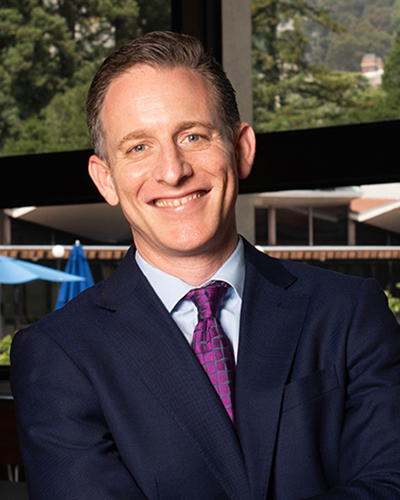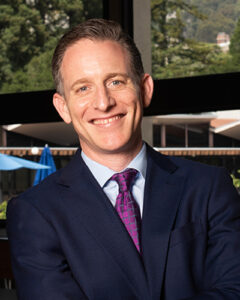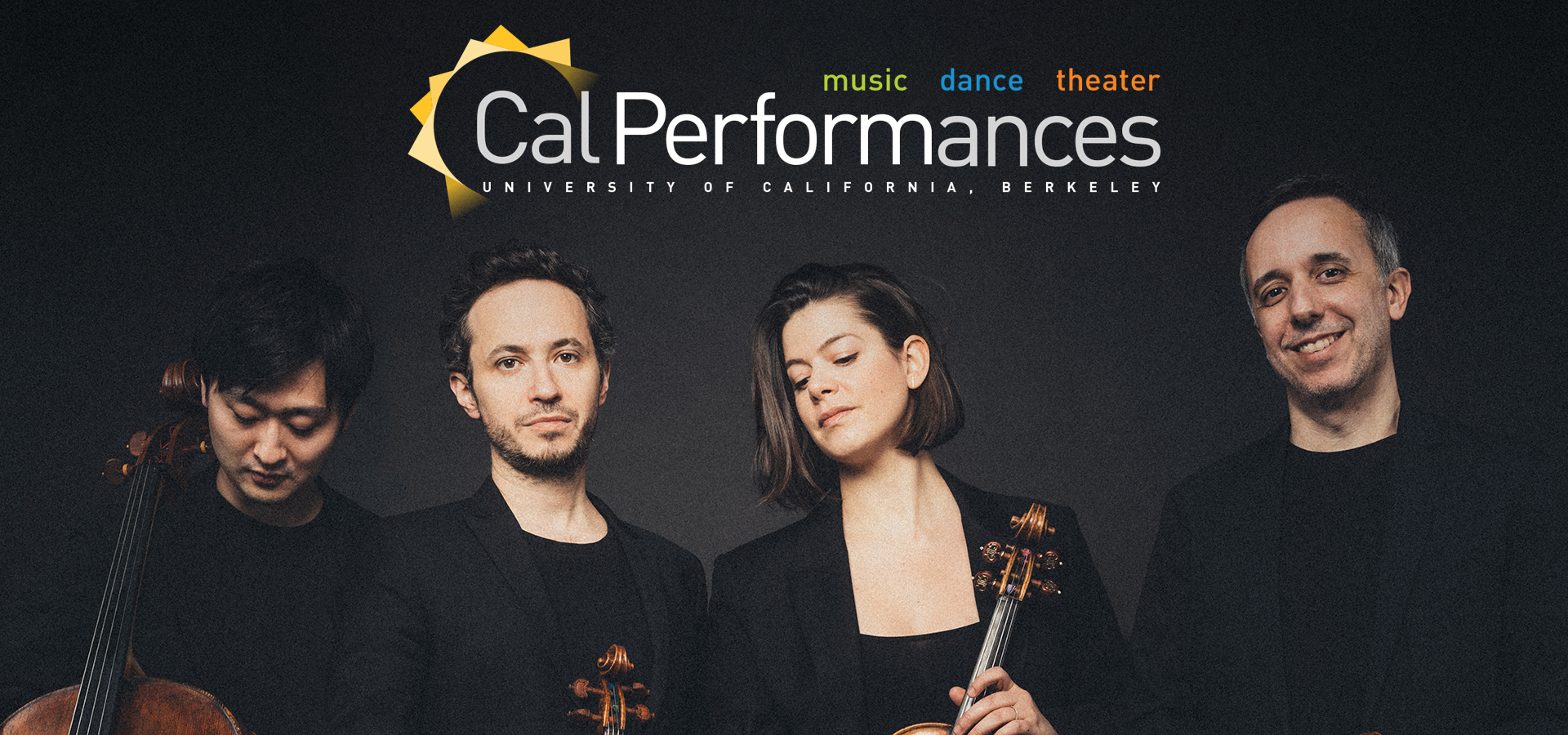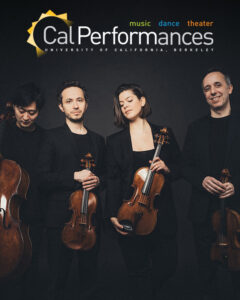Quatuor Ébène
Tuesday, April 16, 2024, 7:30pm
First Congregational Church (also known as First Church), Berkeley
Cal Performances is committed to fostering a welcoming, inclusive, and safe environment for all—one that honors our venues as places of respite, openness, and respect. Please see the Community Agreements section on our Policies page for more information.
From the Executive and Artistic Director

As we enter the final weeks in Cal Performances’ 2023–24 season, it’s natural to take a look back and remember the highlights of a truly remarkable eight months at UC Berkeley. We will all have our favorite moments—instances when a performance seemed to leap off the stage and speak to us directly. But if such experiences are deeply personal, they also all depend on the communal act of gathering together and opening our eyes, ears, and hearts to the miracle of artistic expression. Every day throughout the world, people come to performances to celebrate what it means to be human in an increasingly impersonal world. As this particular season winds down, let me thank each and every one of you for taking part in the magic of great—and live!—music, theater, and dance.
Once again, April means one thing in particular at Cal Performances—Ailey Week—when the renowned Alvin Ailey American Dance Theater returns for its annual spring residency. With its relationship with UC Berkeley now in its 56th year (Ailey has visited campus every non-pandemic year since 1968), the company will present five separate programs from April 2 through April 7. The centerpiece of this year’s residency is the 2024 Gala on Thursday, April 4, with all proceeds benefiting Cal Performances’ artistic initiatives and education programs. During the week, we will also present an Ailey SchoolTime performance for K–12 students and provide an opportunity for alumni of Berkeley/Oakland AileyCamp to reconnect with company members. On opening night, Tuesday, April 2, I’m especially proud that Cal Performances will offer live audio descriptions and a pre-performance haptic tour for blind and visually impaired audience members.
As the season draws to a close in early May, we still have much to look forward to: gifted early-music artists like countertenor Jakub Józef Orliński with the acclaimed ensemble Il Pomo d’Oro (Apr 9) and Jordi Savall with Hespèrion XXI (Apr 12); the thunderous traditional taiko drumming of Drum Tao (Apr 11–12); superb chamber music with the Danish String Quartet and guest cellist Johannes Rostamo (Apr 13) and French ensemble Quatuor Ébène (Apr 16); a duo vocal recital with opera stars (and a husband-and-wife team to boot!) soprano Amina Edris and tenor Pene Pati, with Robert Mollicone at the piano (Apr 23); a highly anticipated return to campus by one of the most adventurous artists on the international pop music scene, the always astonishing Angélique Kidjo (Apr 26); astounding Icelandic pianist Víkingur Ólafsson in a special performance of J.S. Bach’s immortal Goldberg Variations (May 4); and an evening with America’s preeminent humor writer—and frequent guest of Cal Performances—David Sedaris (May 5).
And I must make special mention of the upcoming visit by our dear friends at the Mark Morris Dance Group (Apr 19–21), returning to their West Coast home away from home with a profoundly moving repertory work (2010’s Socrates) and the world premiere of a new Mark Morris creation, Via Dolorosa, set to Nico Muhly’s meditative composition The Street (performed live by harpist Parker Ramsay). In the more than 35 years since the company first appeared at UC Berkeley, Mark Morris’ dancers have treated Cal Performances audiences to the premieres of more than a dozen new Morris works, many of which have gone on to become company classics—don’t miss this chance to be part of dance history!
Finally, I hope you’ll join us on April 16, when we announce our extraordinary 2024–25 season. One major detail has already been announced—the Maria Manetti Shrem and Elizabeth Segerstrom California Orchestra Residency, when Cal Performances and the Philharmonic Society of Orange County will bring the world renowned Vienna Philharmonic and conductor Yannick Nézet-Séguin to California during spring 2025. And I can promise you many more welcome and exciting surprises when full season details are announced.
Again, thank you for joining us this season. I look forward to seeing you again in the fall.
Jeremy Geffen
Executive and Artistic Director, Cal Performances
 As we enter the final weeks in Cal Performances’ 2023–24 season, it’s natural to take a look back and remember the highlights of a truly remarkable eight months at UC Berkeley. We will all have our favorite moments—instances when a performance seemed to leap off the stage and speak to us directly. But if such experiences are deeply personal, they also all depend on the communal act of gathering together and opening our eyes, ears, and hearts to the miracle of artistic expression. Every day throughout the world, people come to performances to celebrate what it means to be human in an increasingly impersonal world. As this particular season winds down, let me thank each and every one of you for taking part in the magic of great—and live!—music, theater, and dance.
As we enter the final weeks in Cal Performances’ 2023–24 season, it’s natural to take a look back and remember the highlights of a truly remarkable eight months at UC Berkeley. We will all have our favorite moments—instances when a performance seemed to leap off the stage and speak to us directly. But if such experiences are deeply personal, they also all depend on the communal act of gathering together and opening our eyes, ears, and hearts to the miracle of artistic expression. Every day throughout the world, people come to performances to celebrate what it means to be human in an increasingly impersonal world. As this particular season winds down, let me thank each and every one of you for taking part in the magic of great—and live!—music, theater, and dance.
Once again, April means one thing in particular at Cal Performances—Ailey Week—when the renowned Alvin Ailey American Dance Theater returns for its annual spring residency. With its relationship with UC Berkeley now in its 56th year (Ailey has visited campus every non-pandemic year since 1968), the company will present five separate programs from April 2 through April 7. The centerpiece of this year’s residency is the 2024 Gala on Thursday, April 4, with all proceeds benefiting Cal Performances’ artistic initiatives and education programs. During the week, we will also present an Ailey SchoolTime performance for K–12 students and provide an opportunity for alumni of Berkeley/Oakland AileyCamp to reconnect with company members. On opening night, Tuesday, April 2, I’m especially proud that Cal Performances will offer live audio descriptions and a pre-performance haptic tour for blind and visually impaired audience members.
As the season draws to a close in early May, we still have much to look forward to: gifted early-music artists like countertenor Jakub Józef Orliński with the acclaimed ensemble Il Pomo d’Oro (Apr 9) and Jordi Savall with Hespèrion XXI (Apr 12); the thunderous traditional taiko drumming of Drum Tao (Apr 11–12); superb chamber music with the Danish String Quartet and guest cellist Johannes Rostamo (Apr 13) and French ensemble Quatuor Ébène (Apr 16); a duo vocal recital with opera stars (and a husband-and-wife team to boot!) soprano Amina Edris and tenor Pene Pati, with Robert Mollicone at the piano (Apr 23); a highly anticipated return to campus by one of the most adventurous artists on the international pop music scene, the always astonishing Angélique Kidjo (Apr 26); astounding Icelandic pianist Víkingur Ólafsson in a special performance of J.S. Bach’s immortal Goldberg Variations (May 4); and an evening with America’s preeminent humor writer—and frequent guest of Cal Performances—David Sedaris (May 5).
And I must make special mention of the upcoming visit by our dear friends at the Mark Morris Dance Group (Apr 19–21), returning to their West Coast home away from home with a profoundly moving repertory work (2010’s Socrates) and the world premiere of a new Mark Morris creation, Via Dolorosa, set to Nico Muhly’s meditative composition The Street (performed live by harpist Parker Ramsay). In the more than 35 years since the company first appeared at UC Berkeley, Mark Morris’ dancers have treated Cal Performances audiences to the premieres of more than a dozen new Morris works, many of which have gone on to become company classics—don’t miss this chance to be part of dance history!
Finally, I hope you’ll join us on April 16, when we announce our extraordinary 2024–25 season. One major detail has already been announced—the Maria Manetti Shrem and Elizabeth Segerstrom California Orchestra Residency, when Cal Performances and the Philharmonic Society of Orange County will bring the world renowned Vienna Philharmonic and conductor Yannick Nézet-Séguin to California during spring 2025. And I can promise you many more welcome and exciting surprises when full season details are announced.
Again, thank you for joining us this season. I look forward to seeing you again in the fall.
Jeremy Geffen
Executive and Artistic Director, Cal Performances
About the Program
Wolfgang Amadeus Mozart
String Quartet No. 21 in D major, K. 575, Prussian (1789)
Friedrich Wilhelm II, King of Prussia, delighted in Mozart’s company when the composer visited the court in Berlin in the spring of 1789. Like his father, Frederick the Great, Friedrich Wilhelm loved music. An accomplished cellist with a royal ego, he would have relished the prospect of playing things an artist of real stature intended for him, and so Mozart headed back to Vienna with a commission for six string quartets. It could have been a windfall. Mozart needed the money desperately. The only hitch was that payment would be made upon receipt of the music.
The quartet we hear this evening, the first of those meant for the king, was completed by June 1789, just before life began closing in on Mozart. With little or no income, he faced mounting financial troubles. A family medical emergency brought unexpected bills. A new opera, Così fan tutte, demanded his attention. And he needed to find other living quarters for his family. Laboring under such stress, Mozart managed to complete only three of the quartets for the king, and because he failed to deliver all he had promised, the treasury in Berlin paid only for what the court had received.
Mozart is often thought to have been blessed with miraculous powers. When we consider that music so sunny and felicity-drenched as K. 575 emerged in the midst of wretched personal circumstances, we might be tempted to believe he was guided by extra-terrestrial forces. But we need not go that far. Sure, Mozart was a genius. What we often forget is that he was also a pro. K. 575 proves that.
With no introduction, and as though the musicians had been playing before we hear their first notes, we stumble upon an unexpected delight: the second violin, then the first, singing the elegant theme that will saturate this elegant movement. Notice the cello, who sits silent as the music begins but then introduces figures the others take up, as if he directs the proceedings before entering the conversation himself. (Mozart ensured that the king, an accomplished cellist, received a starring role in this music.) The materials of the movement are few and ingratiating, and they bear continued repetition, changing guise only in the development, which is so brief it seems less a structural necessity than a concession to sonata form.
Brief and graceful, the Andante unrolls as a rhapsody, packed with melodic elements in a four-minute span. About a minute (or 20 bars) into the movement, the first violin spins a long melody taken up in turn by cello, second violin, and viola. This, the
Andante’s second theme, is soon followed by a third before the opening is reprised and the movement ends.
The minuet seems designed more for the sawdust-covered floor of a country tavern than for the palace ballroom. The movement’s outer sections feature a light-footed dance that gives way to a contrasting passage, rustic and mock-serious. In the central trio section, the cellist is featured soloist, singing a long-lined ballad.
What we hear as the finale begins recalls the quartet’s opening, and that recollection will dominate this rondo movement. The minor mode intrudes to an extent not yet heard in the work, but the prevailing mood is upbeat and joyful.
Alfred Schnittke
String Quartet No. 3 (1983)
If this quartet from 1983 is your first encounter with Alfred Schnittke, you may believe its opening prepares you for a soothing meditation. A few more seconds will shatter your expectations and tell you a few things about this man: that he was a polystylist, and that he wrote the kind of music you’d guess the Soviet authorities would have hated. (For the most part, they did.)
Schnittke was born to a German father and a Volga-Deutsch mother in Engels, an industrial city about 450 miles southeast of Moscow. At 12, he began to study music in Vienna, where his journalist father had been transferred. Schnittke completed his studies at the Moscow Conservatory and taught there until 1972, when he began supporting himself by composing for film. He scored 60-odd movies, and that work, demanding quick responses to the ever-changing emotional twists of plot, conditioned the style of his concert music. His enormous output included nine symphonies, three operas, four string quartets, and many, many concertos.
With the international honors his music was receiving, and in a Soviet Union beginning to relax its strictures on artists, Schnittke was spared the indignities and bullying heaped on earlier Soviet composers. But no bureaucrat could have been happy with something as deeply strange as his Symphony No. 1, a love-it-or-loathe-it hour of dissonance that sounds like the work of a Russian Charles Ives and that demands so much patience and serious listening, it practically begged the Composers Union to ban it (the Composers Union obliged). Schnittke so displeased the authorities that in 1980 he was prohibited from traveling outside the country. In 1990, a year after the Berlin Wall fell, he settled in Hamburg, where in 1998 he died at 63.
The String Quartet No. 3 is the kind of emotion-laden work you might expect from a composer so closely attuned to film. Very simplistically, you can take polystylism to mean the incorporation and refashioning of found objects into your own work. The quartet begins with a quotation from the Stabat mater by the 16th-century Flemish composer Orlando di Lasso, establishing a serenity immediately dispatched by a drone that grows louder and tighter under the second violin’s plucked strings. In a film, this ominous figure might accompany careful steps into a dark room; in musical terms, it recalls the opening of Beethoven’s Grosse Fuge. The melodic gesture from Beethoven is not so far from Shostakovich’s signature DSCH motif, and that too is submerged in the texture (the names German assigns to musical tones enabled Shostakovich to notate his initials; translated into English, they are D/E-flat/C/B). A disintegration morphs into languid siren-like lines. While apparently quoting Orlando di Lasso, Beethoven, and Shostakovich, Schnittke transforms their themes—as though viewing them through a prism—and builds a tight structure all his own.
The second movement begins as a kind of waltz, but again Lasso intrudes. Roughly halfway through, the mood reverts to the mysterious atmosphere of the quartet’s opening. The tempo shifts into overdrive and, as in Beethoven’s fugue, verges toward chaos. The final movement, following with no break, opens with a grand Grosse Fuge-like gesture. Lasso returns, and Beethoven, in an extended meditative passage, subdued and tense to the end.
You don’t need to know where Schnittke found his themes, although awareness of his sources will undoubtedly help read extra-musical meaning into the work, if you’re so inclined. (Some listeners have interpreted the conglomeration and wrenching apart of snippets old and new to suggest integration, or breakdown, or both.) Schnittke maintained his goal was to unite serious and light music, by which he had to have meant something beyond what many other composers have done, composers such as Beethoven, Brahms, Dvořák, Stravinsky, Copland, Adams. “It’s not surprising,” writes Solomon Volkov, “that Schnittke’s music irritates many who feel that the composer has set out to confuse them by combining obviously disjointed and incongruous elements.” All that aside, music works better as music than as philosophical statement. As music, this quartet stands on its own.
Edvard Grieg
Quartet No. 1 in G minor, Op. 27 (1878)
Many music lovers think of Edvard Grieg as a two-hit composer, those hits being his Piano Concerto and his incidental music for Ibsen’s Peer Gynt, which actually includes a subset of hits such as “Morning Mood” and “In the Hall of the Mountain King.” If you claim you’re familiar with this string quartet, you will either be an especially cultivated listener, or you’ll be kidding. While his Piano Concerto is among the most loved of all concert works, Grieg’s String Quartet No. 1 is one of the least known.
Unlike the handful of works that have earned Grieg his place in the repertory, this quartet of 1878 offers few tunes that drill their way immediately into the ear—despite the fact that it includes hints of folk music, or that references to Grieg’s song “Spillemaend” (“The Minstrel”) run through it (this tune appears initially about two minutes in, introduced as the roiling subsides and the first violinist commences with a lyrical interlude; it reappears in the introduction to the final movement and again at the very end). And while composers such as Liszt and Tchaikovsky admired the quartet, critics treated it badly, faulting it not for what it contained, but for what it lacked—meaning it failed to meet their conventional expectations, which Grieg had never aimed to fulfill at all.
For this is no orthodox quartet. Having just heard quartets by Mozart and Schnittke, your ears will be accustomed to music that moves not simply in a horizontal line, from start to finish, but which also (and at the same time) moves vertically, lending a sense of depth to any given moment. Grieg’s quartet moves primarily in one straight line. It is homophonic with a vengeance.
So you may be startled by the Grieg. Perhaps it will sound as though something is missing. I once reacted like this when, after a long bout of reading Henry James’ architecturally elaborate sentences, I turned to Graham Greene’s spare prose. The experience was something like the uncharacteristic ease of lifting a 20-pound weight after a week of working out with 100 pounds. This is not to say that either Graham Greene or Edvard Grieg are lightweights, nor that more is necessarily better. But we ought to be prepared for what lies ahead. As Grieg’s critics were not.
Grieg’s string writing here has been called “semi-orchestral,” a nod to its big sound, achieved with an abundance of double stops. The music unfolds like a narrative, seeming to reflect psychological states more than to present a musical argument. It advances in episodes (punctuated throughout with a gesture like that heard in the keyboard chords that open Grieg’s Piano Concerto) and includes heated drama presented in big, silent-movie gestures; tender, dreamy interludes; elegant salon music (the lyrical sections of the bipolar second movement); and the dances of Grieg’s native Norway (he may call the last movement a saltarello, but Italy never spawned music like this).
Today we encounter Grieg more often on pops programs than in “serious” concerts, but this quartet shows how wrong we are to pigeonhole him. As much as the unexpected dissonances must have riled critics in 1878, this music’s hand-wringing passion—which displays a little-known side of Grieg—is contained within a musical structure based more on motifs and rhythm and dramatic gesture than on any conventional form—the sort of thing Grieg’s critics sought in vain to find here. Little did they know he was pointing in a direction others would one day follow.
—Larry Rothe
Larry Rothe writes about music for Cal Performances and San Francisco Opera. Visit larryrothe.com.



